 |
Commentaries on Saints
St. Philomena, Wonder Worker
Died August 10; Feastday August 11
Ellyn Miller
I am a devotee of St. Philomena. I promised her that if she would bring my Navy Seal son home safely from the war against terrorism in Iraq, I would do what I could to make her better known. He came home unharmed, having been in the heat of the battle from beginning to end. So, here I am, a grateful mother accomplishing my part of the agreement, after St. Philomena so graciously fulfilled hers.
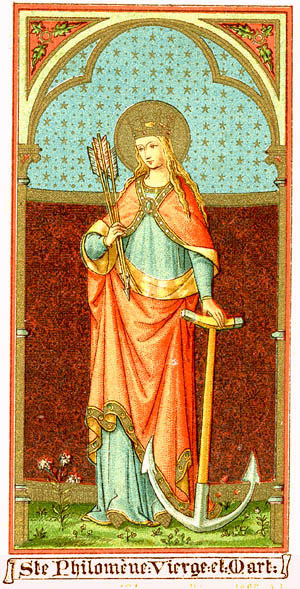
St. Philomena, Virgin and Martyr
|
When I started to prepare this article, I had a problem. I had to face the fact that Pope Paul VI had removed my saint from the liturgical calendar. It seems that the alleged reason was lack of historical documentation regarding her life. I am not a historian, nor an expert on liturgy, far from that. I just know that St. Philomena without the approval of Paul VI continues to work from Heaven as much as ever and to give enormous graces to Catholics who have recourse to her. Therefore, she did not take this “annulment” seriously. And neither did I.
Am I being disobedient, since I continue to pray to her? I don’t think so. Her devotion was approved by many other Popes before the “annulment.” Pope Gregory XVI, the first who knew about her devotion, called her “the wonder worker of the 19th century” and declared her a saint. He wrote: “Pray to St. Philomena. Whatever you ask from her she will obtain for you.”
Pope Leo XII granted permission for erection of altars and churches in honor of St. Philomena. Pope Pius IX declared her Patroness of the Children of Mary. Pope Leo XIII raised the Confraternity of St. Philomena to an Archconfraternity and approved the cord of St. Philomena. (1) St. Pius X, after raising this association to a level of Universal Archconfraternity and declaring St. John Baptist Vianney its patron, wrote these decisive words:
“To discredit the present decisions and declarations concerning St. Philomena as not being permanent, stable, valid and effective, necessary of obedience, and full effect for all eternity, proceeds from an element that is null and void and without merit or authority.”
With all this papal support for my saint, I don’t have a bit of doubt about praying to her, and I invite you to do the same.
How did St. Philomena first show herself?
Imagine this scene. It is May 25, 1802, and a team of Catholic archeologists is working in the Catacomb of St. Priscilla in Rome. They are making their annual excavation in this “gold mine,” where one can find countless shelf tombs with remains of martyrs who were killed during the Roman persecutions.

The shelf tombs that hold the precious remains
of the martyrs in a Roman catacomb.
|
At a certain place, the specialists come across this enigmatic inscription on several tiles: LUMENA PAXTE CUM FI. They move the tiles and arrange them together in a different way. The inscription becomes PAX TECUM FILOMENA – Peace be with you, Filomena. After more than 1600 years, St. Philomena’s tomb is discovered!
Inscribed on the burial tiles they also notice some symbols: an anchor, several arrows and a lily. They don’t understand the significance – the explanation will come later. After carefully laying aside the tiles, they examine the remains in the tomb. Scientific tests reveal it to be the body of a 12 to 13-year-old girl. The ensemble – body and tomb – is determined to date no later than 160 AD.
A dried brown substance is found a small glass vial along with the remains. The tests show it is dried blood. When the particles are transferred to a new clear glass vial, they are transformed into shiny precious stones, and then return to the original form. Let me point out here that this miracle did not happen just once. Cardinal Ruffo Scilla witnessed the same marvel in 1847 and testified to it in a solemn declaration. Cardinal Auguste de Champs also witnessed this. In 1909 Fr. Paul Sullivan, a Portuguese Dominican, visited the site and experienced the same phenomenon, and not just once. He wrote that he examined “the priceless treasure 30 or 40 times, and each time without fail I saw the blood change most marvelously.”
With that first miracle, so quick in coming, the scientists understood that they were dealing with the relics of a saint. So they sealed the remains in an urn and sent it to the Custodia Generale, the general custodian for relics at the Vatican.
A golden chain of miracles
Three years later, Don Francesco di Lucia, a parish-priest from a small town close to Naples called Mugnano, traveled to Rome accompanying a friend who had been chosen to be the new Bishop of Potenza, and would be consecrated there.
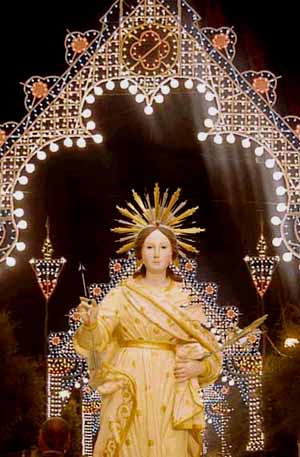
The first statue of St. Philomena, made in 1823
|
Don Francesco went to visit the Custodia Generale seeking the relics of a virgin martry for his parish to restore purity among the youth, who were already being corrupted by the bad customs of the French Revolution. When he approached the relics of St. Philomena he was filled with an inexplicable spiritual joy. He asked the director for her relic, but was refused. Unfortunately for him, her relics were classified as worthy of “special places,” and his Mugnano parish did not qualify as such. He persisted, asking his friend, the newly consecrated Bishop, to use his influence to obtain a relic of St. Philomena. The Bishop was more successful, and so St. Philomena began her journey to Mugnano via Naples.
In the carriage of the Bishop and Don Francesco, the relic had been placed under the seat where the Bishop would travel for the return journey from Rome. As the carriage prepared to set out, he suddenly felt a strong blow on his leg. It was a package that moved from its place. The package was firmly repacked under the seat. Twice more it dislodged itself and rapped the Bishop solidly in the legs, each time harder.
It was only then that both the Bishop and Don Francesco realized that the package contained the relic of St. Philomena. She was not at all pleased about being relegated to such a site! The relic was removed to an honorable place in the carriage, and then the trip could proceed.
In Naples the relic was placed in a poorly made paper maché figure of very bad taste that was dressed to represent the saint. This image was positioned in a glass-sided ebony shrine too small to accommodate it properly, so that the figure was forced into a very unbecoming position. This situation positively was not to the liking of St. Philomena. Later, in Mugnano the saint would not only miraculously alter the features of the figure, but also assume a different size and dignified position in the shrine.
But even with that ugly image, miracles began to take place through her intercession. Before the procession from Naples to Mugnano, a woman whose hand was so gangrened that it should be amputated, was suddenly cured when she touched the relic of St. Philomena. As soon as the saint arrived in Mugnano, the people there began to feel her beneficent presence and receive her miracles. A crippled man could walk, and a blind child could see. She also began her own transformation inside the sealed shrine: her hands changed position, her features became beautiful, her complexion took on a flush, her lips now gently smiled. Many people witnessed St. Philomena open and close her eyes. She was quite playful – once she turned around and smiled for a group of pilgrims; another time she changed her position for all to see before a procession.
St. Philomena’s fame grew far and wide. The devotion spread like wildfire. Shrines, chapels, and statues sprang up all over Italy, France and England. The miracles continued: a child who had died returned to life after the mother placed a picture of the saint on the child’s body; a blind nun regained her sight by touching a picture of the saint to her eyes; a young woman who was alone in childbirth was visited by St. Philomena who assisted her. The wife of a wealthy barrister who was near to death went to St. Philomena to make a bargain. If the saint would cure her husband or at least give him the disposition of spirit to make a good confession, she would provide a marble altar for her chapel. He was completely cured at the last moment.
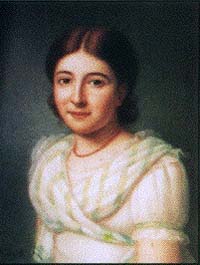
Ven. Pauline Jaricot,
cured by St. Philomena
|
St. Philomena’s most illustrious miracle took place with Pauline Jaricot, the daughter of a French family known for their charity. Pauline, the founder of the Living Rosary and the Association for the Propagation of the Faith, had become gravely ill and was quickly approaching death. Her last desire was to visit Mugnano. Her doctor allowed her to go, stating that she might as well make the difficult trip, since “it is all over for her.”
Reclining in a sick-chair, unable even to walk, and accompanied by her chaplain and some servants, she crossed the Alps and went to Rome, where she asked for a blessing of the Holy Father. Her health had further declined since she had suffered another heart attack on the journey. In this grave condition, she met Pope Gregory XVI at the Sacred Heart Convent of Trinità dei Monti. Pauline asked the Pope for a favor: If she would return from Mugnano cured and walking, would he proceed with the examination of the cause of St. Philomena? The Sovereign Pontiff agreed, saying: “That would be a miracle of first class.”
Pauline arrived in Mugnano in August 8, 1835, weak and exhausted. On St. Philomena’s feast day – August 10 – she was in the church praying. At a certain moment she became completely still and immobile, giving no signs of life. The people around her thought she had died.
But the opposite was true. She was in a kind of ecstasy of supernatural joy – she had been completely cured. The news spread and the church bells were rung to proclaim the miracle. Doctors examined and tested her: not only was she able to walk again, but she had regained the health of her youth.
In thanksgiving, Pauline consecrated herself to St. Philomena. She asked for a relic, which was readily given to her. On her return trip to Rome, she was greeted by the people, who had already heard news of her instantaneous recovery. The Pope could not believe his eyes at the great miracle that had occurred. On January 30, 1837, Gregory XVI authorized public veneration of St. Philomena. A special feast day was appointed her, and a lesson inserted in the Breviary.
On her return to France, Pauline stopped at Ars and gave a part of her relic to the Cure, St. John Vianney, who would become one of St. Philomena's greatest devotees. Between the Cure of Ars and St. Philomena there was a special understanding and sympathy. He attributed all his miracles to his “dear little saint.”
How does St. Philomena obtain so many favors for her devotees? In a vision she was shown laying down her martyr’s crown before the throne of Our Lady and saying: “Lady of Heaven, I come to request a grace.” Then she asked for more than 30 different graces for various persons. Our Lady replied: “To Philomena nothing is refused. I concede to her all these graces.”
The history of her martyrdom
St. Philomena herself related the history of her life and martyrdom to different persons in private revelations. The very same facts were given by the saint to a nun, a priest and an artisan, in different places and dates. For brevity’ sake, I will repeat only the revelations of the nun, Mother Maria di Gesù, an Italian Dominican Tertiary who died in odor of sanctity. Here they are.
St. Philomena was a Greek Princess, the only daughter of a minor Grecian king married to a noble with royal blood. The couple had no children and prayed to the idols for a child. A doctor of their court, a Christian Roman named Publius advised them “to be baptized in the Religion of Jesus Christ,” and pray to the true God for a child. They consented and converted, along with other members of their court.
A year later the saint was born and called Lumina – light – because she was born in the light of the Catholic Faith. She was affectionately called Filumena which means Daughter of the Light, the light of Christ that dwelt in her soul when she was baptized. She received the Holy Eucharist when she was five, and when she was eleven she made a vow of consecration to Our Lord.
In her thirteenth year, the Emperor Diocletian initiated a war against her father’s small kingdom. Accompanied by his wife and daughter whom he could not bear to leave his side, he went to Rome to meet with the Emperor and plead with him to cease the war. Diocletian could not keep his gaze from Philomena. After her father had pleaded his case, the Emperor told him he would not need to worry about the war if he would give his daughter to him as his wife.
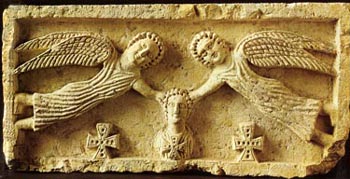
Tiles in the catacombs illustrate the assistance of Angels given to Martyrs during their sufferings. Below, the angels delivering the palm of martyrdom to St. Philomena
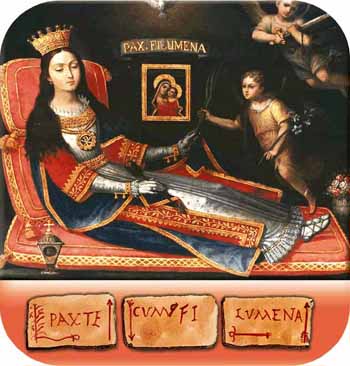
|
The parents accepted, but Philomena refused, saying that God was her father and Heaven her mother. When her parent’s pleas could not persuade her to change her mind, Diocletian ordered that she be thrown in a dungeon and chained hand and foot as reprisal for her refusal. Every day he visited the dungeon to renew his offer to the beautiful princess.
On the 36th day, Our Lady appeared to her with her Divine Infant and told the young girl that she would be released after three more days. Then, Our Lady told her, she would be exposed “to a great battle of atrocious torments for the sake of my Son.” She promised to be her helper, along with the Archangel Gabriel, so that she would be victorious.
In fact, three days later Philomena was released, and the next day Diocletian ordered her to be bound to a pillar and scourged and sent back to the prison to die. Two angels appeared in the cell and anointed her with oils that healed her. The tyrant, furious upon seeing her more beautiful than ever, ordered that an iron anchor be tied around her neck and that she be thrown into the Tiber. Our Lord sent to her two angels, who cut the rope before many witnesses, and the anchor sunk into the Tiber without Philomena. The serene princess was returned to shore without a drop of water touching her.
Now, the Emperor ordered that she be shot with arrows. Wounded, she was returned to the prison, where again the angels healed her. Enraged, he ordered her shot through with burning arrows until she was dead. But the arrows sent speeding from the bows toward her body turned back against the archers, killing six of them.
Finally, Diocletian ordered her to be beheaded. And so her soul fled earth, where she could have had all the earthly wealth and glory as the Emperor’s wife, and escaped to Heaven to receive the more glorious crown of martyrdom and virginity. This happened on Friday, the tenth day of August, at 3:30 in the afternoon. And here you have the explanation for the symbols of the anchor, the arrows and the lily found at her tomb, and presented often in pictures of her.
These are the principal data on the life and miracles of this extraordinary young Greek Princess who had, notwithstanding her age, the grandeur and gravity of a Queen.
You will find that when you pray to her, she establishes a wonderful relationship with you, and in a short time you can discern her personality. A young girl, she likes to play, the way she did with the Bishop, kicking his leg. She likes to smile – she even changed the features of the statue at Mugnano to represent her lightness and joy. At the same time, she had a great firmness of will - she would not bend in her fidelity to remain a spouse of Our Lord, and not some earthly king. Thus she brings to your soul the seriousness of a saint and the joviality and amiability of a girl. These facets of her personality make her extremely accessible, and friendly.
She is the patroness of sailors – so naturally I put my son under her protection. She is also the patroness of youth, the childless and expectant mothers, the protector of marriages. She helps with heartache and despair – and who doesn’t experience that in these difficult days? – and she gives hope. Another area where she is especially powerful is in helping with financial problems. I could go on and on.
I am speaking from experience when I say that to have a friendship with St. Philomena is a pleasure that makes life easier to live and brings hope and consolation to those who call upon her, no matter what the situation.

Novena Prayer 1
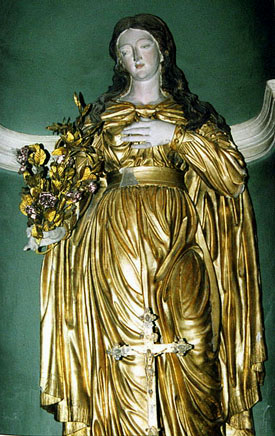
St. Philomena, powerful with God,
pray for us
|
O faithful Virgin and glorious Martyr, St. Philomena, who works so many miracles on behalf of the poor and sorrowing, have pity on me. Thou knowest the multitude and diversity of my needs. Behold me at thy feet, full of misery, but full of hope.
I entreat thy charity, O great Saint! Graciously hear me and obtain from God a favorable answer to the request which now humbly lay before thee ... (here specify your petition).
I am firmly convinced that through thy merits, through the scorn, the sufferings and the death thou didst endure, united to the Passion and Death of Jesus, thy Spouse, I shall obtain what I ask of thee, and in the joy of my heart I will bless God, Who is admirable in His saints. Amen.
Imprimatur: + Carolus Hubertus Le Blond,
 Episcopus Sancti Josephi Episcopus Sancti Josephi
 January 1952. January 1952.

Novena Prayer 2
Illustrious Virgin and Martyr, St. Philomena, behold me prostrate at the foot of the throne where it has pleased the Most Holy Trinity to place thee.
Full of confidence in thy protection, I beseech thee to intercede for me with God. Ah! From the height of thy heavenly throne, deign to look upon thy humble servant. Spouse of Jesus Christ, console me in my trouble; strengthen me in temptations; protect me from the dangers that surround me on all sides; obtain for me ... (mention request) and especially and above all, assist me at the hour of my death. Amen.
St. Philomena, Virgin and Martyr, pray for us, so that through thy powerful intercession we may obtain that purity of mind and heart which leads to the perfect love of God. Amen.
1. The cord of St. Philomena, the instrument of innumerable favors and cures, is used by the sick and is a protection against accidents and evils of every kind. The cord is worn especially as a safeguard of the virtue of chastity, according to one’s state of life. It is usually worn around the waist, under one’s clothing, or it may be placed under the pillow, over the door, or in the wallet or purse. Pope Leo XIII gave special privileges and indulgences to all who use it.
|
Saint of the Day | Home | Books | CDs | Search | Contact Us | Donate

© 2002- Tradition in Action, Inc. All Rights Reserved
|
 |

|